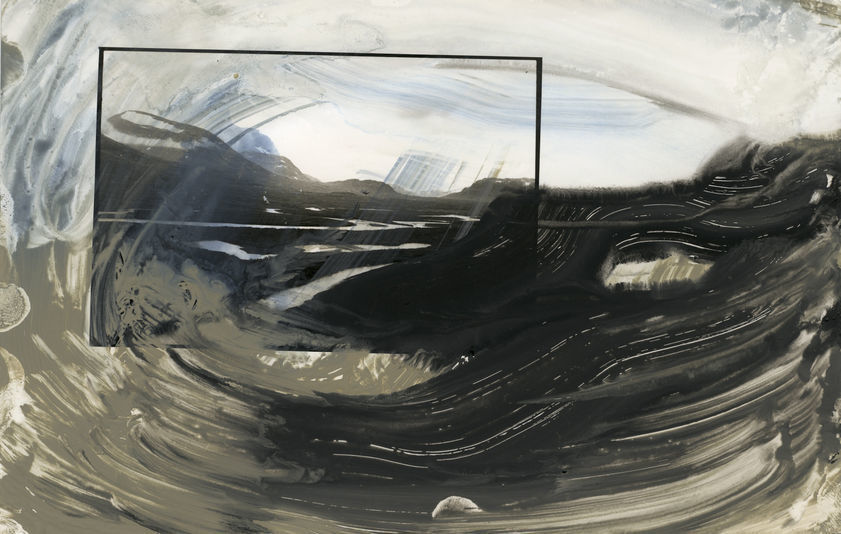Ian McKeever 1977
Ian McKeever has been working with images of landscape for a long time. However his work as a painter gradually grew out of a conceptual interest in landscape that used drawing as a vehicle to reveal time and place as moments of photographic capture. Back in the 1970s conceptualism was a powerful driver of art practice and there was a focus on the methodologies that lay behind representation. In particular photography was often used as a measure of time. For instance; focusing on a snow-laden bush of spiky branches, Douglas Huebler photographed it twelve times from a fixed position at fifteen minute intervals. He was also interested in the idea of a photograph also undergoing a material transformation, the silver gelatin printing process allowing for a very beautifully controlled set of tonal variations that reveal the role of light in relation to the underling negative-positive process of the medium in which he is working. He regarded this type of work as sculpture and had this to say about that; "The existence of each sculpture is documented by its documentation".
Douglas Huebler: Duration Piece #11: 1969
This type of gridded documentation was very influential when I was studying sculpture in the early 1970s and you can see how McKeever was using it to present his own take on the documentation of the coastline.
Ian McKeever: 1972: 'Tree painting' for grassy lowland-scape: Photography and drawing
Ian McKeever: 1971: Withernsea, Yorkshire Painting with extensions: Oil on canvases in 2 wooden boxes, with textured ceramic balls
Ian McKeever: Studio set up
As you can see from the studio shot above, he began bringing the landscape back into the studio. Painting, drawing and photography are enmeshed together.
Ian McKeever: Seascape with photograph
Gradually the painterly recreation begins to escape the photographic documentation.
Ian McKeever: Assumption
In painting such as Assumption, it is the quality of light that interests McKeever, rather than a documentation of the landscape. The manipulation of paint on canvas makes a landscape in its own right. As the paint is moved around, it is as if he is re-creating the forces of light, wind and rain and how they interact with a geologic substrata.
Ian McKeever: Waterfall 3 1979
You can see the split between photographic documentation and painterly recreation beginning to come about if you look at McKeever's 'Waterfall' series of images from the late 1970s. He juxtaposes the photographic document with a drawn recreation of the same place. The drawings begin to 'escape' the dictates of the photograph, they make their own reality, just as the landscape does.
Lucas Arruda
These paintings are a type of abstraction, the use of a horizon line gives a sense of a landscape of distance and atmospheric space. When seen in the flesh, the materiality of the paint, combines with the brain's tendency to see landscapes, and the art historical references point to the romantic sublime. I like them because they waver between things, sitting on an edge between genres, whilst being very enjoyable paintings, that are very much about paint.
Christopher Prout is an artist working with the English landscape that I have often looked at as someone operating in a very interesting space between an abstract expressionist sensibility, one of making paintings that achieve their impact and expression through the way they are painted, and an observational practice, that attempts to capture the images of particular places and atmospheric conditions. While looking at his work your mind can switch between an awareness of the painting as object and the painting as a window.
Lucas Arruda
Lucas Arruda
Christopher Prout is an artist working with the English landscape that I have often looked at as someone operating in a very interesting space between an abstract expressionist sensibility, one of making paintings that achieve their impact and expression through the way they are painted, and an observational practice, that attempts to capture the images of particular places and atmospheric conditions. While looking at his work your mind can switch between an awareness of the painting as object and the painting as a window.
Christopher Prout
Christopher Prout
Sue Bryan
Nils-Udo: Beech and Rowen Berries
Artists such as Nils-Udo and Andy Goldsworthy have used the materials of nature to make their drawings and site specific installations, whilst collaborative ventures such as Red Earth have undertaken performances and have become much more directly involved in the preservation of landscapes.
Red Earth
Whether you are trying to make people aware of the beauty and wonder of landscape by making images of it or are being much more environmentally politically active, (as in the work of Agnes Denes), doesn't matter, what is important is that you become more aware of how our future is inextricably linked to the fate of the landscapes that surround us; not just the ones we can see out of the window, or as we travel through the countryside, but also the landscapes that we cant see, but which are still effecting us everyday, such as the Amazon and the Antarctic, huge areas of land that have both been severely effected by climate change and human intervention.


















Thanks for sharing these ideas about using marble in interior design.
ReplyDeleteIrish landscape photography
Ireland scenic views
Natural beauty of Ireland
Wild Atlantic Way
Cliffs of Moher landscape
Irish countryside vibes
Green landscapes of Ireland
Ireland hiking trails
Best landscape spots in Ireland
Emerald Isle nature
Thanks for sharing these ideas about using marble in interior design.
ReplyDeleteSwiss landscape design
Alpine gardens Switzerland
Scenic views Switzerland
Landscape architecture Zurich
Natural beauty Switzerland
Outdoor living spaces Switzerland
Sustainable landscaping Switzerland
Modern garden design Switzerland
Landscape contractors Switzerland
Mountain views real estate Switzerland